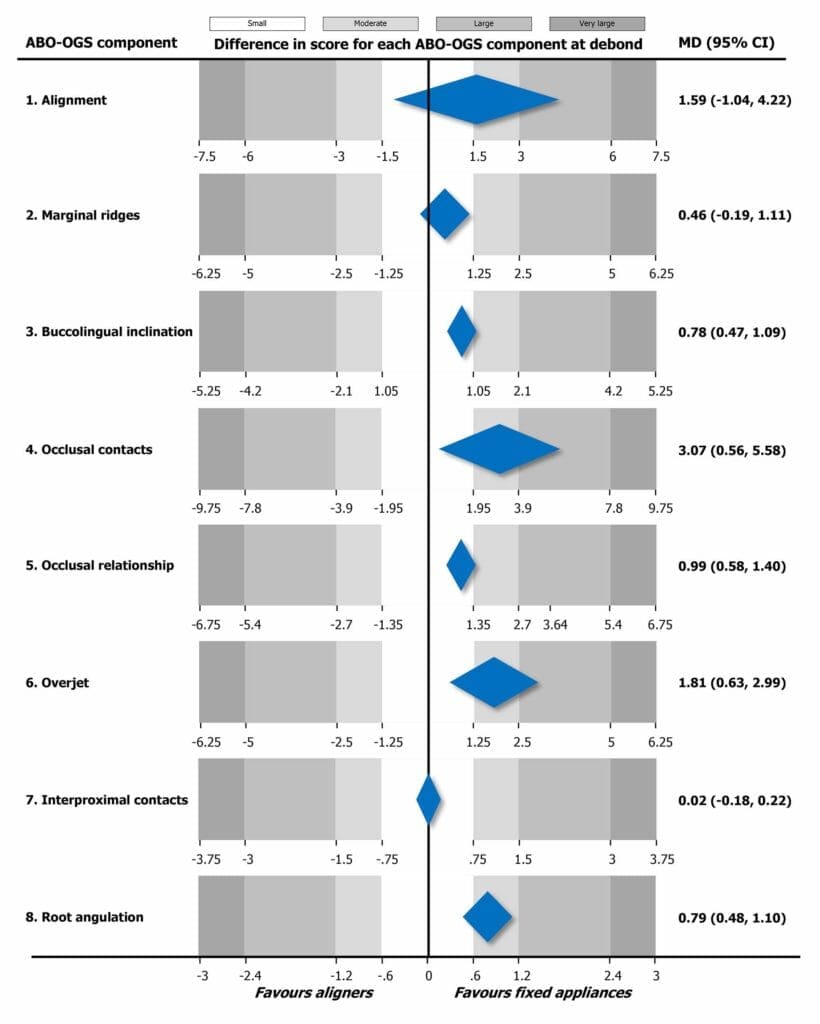Back to Basics: Clinical outcomes with aligners versus fixed appliances
Introduction
This is the final post in the “Back to Basics” series on clear aligners. In this post, Martyn Cobourne gives a nice summary of the evidence on clinical outcomes of aligner treatment compared to fixed appliances.
There is little doubt that clear aligner treatment continues to increase in popularity, and as these systems evolve, orthodontists are developing increasingly ingenious ways to manage more complex malocclusions with these appliances. However, biomechanically, they remain inferior to conventional fixed appliances, and it is important to understand how effective they are concerning treatment outcomes. Following some helpful discussion with Spyridon Papageorgiou, I have put his summary together.
Effectiveness of Aligners on occlusal outcomes
Current evidence is based primarily upon matched non-randomised studies interspersed with a few small-volume RCTs, which makes it of moderate (to low) quality at best (Papageorgiou et al., 2020):
- Investigators have done studies using the American Board of Orthodontics Objective Grading System (ABO-OGS). They have concluded that aligner treatment has significantly worse occlusal outcomes and more patients with unacceptable results compared to fixed appliances.
- Within the ABO-OGS, variation exists in the success of aligner treatment in managing different aspects of malocclusion (See Figure 1); however,
- Using the Peer Assessment Rating (PAR), there are no differences between aligners and fixed appliances in terms of final PAR score or PAR reduction (this apparent contradiction with the ABO-OGS data is possibly related to the PAR being a less rigorous evaluation of tooth position within the dental arches and a more representative measurement of baseline case severity; indeed, post-treatment ABO-OGS and PAR scores do not generally correlate).

Other outcomes
Several systematic reviews have investigated multiple aspects of clinical effectiveness with aligners versus fixed appliances. Investigators have recently synthesised these findings, but we should remember that again, the level of evidence is only moderate to low, and the synthesis quoted here lacks quantitative analysis incorporating risk of bias assessment for these studies (Yassir et al., 2022):
- Aligner treatment is effective for mild to moderate malocclusion requiring simple tooth movement, but is less effective than fixed appliances for more severe crowding and complex cases;
- Treatment duration has been reported to be shorter with aligner treatment compared to fixed appliances for mild to moderate cases; however, treatment duration studies need to be carefully controlled for equivalence, particularly when there is a likelihood of milder malocclusions being treated using aligners and evidence of poorer occlusal outcomes for aligners (Papageorgiou et al. 2020);
- Aligners are associated with a higher tendency for relapse compared to fixed appliances, possibly related to the increased proclination and expansion of teeth that occurs with aligners or possibly to the worse occlusal outcomes. (Angst et al., 2021) or both?;
- Aligner treatment is associated with better periodontal index scores and periodontal outcomes compared to fixed appliances, but the evidence is limited (Oikonomou et al., 2021);
- There is little robust evidence of any differences between aligners and fixed appliances in terms of orthodontic-induced external root resorption (OIRR) (although the data is sparse and probably underpowered); aligners seemingly show less OIRR, but after calculating how much aligners move the teeth (especially the root apex) less OIRR is most likely due to less movement – when you account for this there are no differences between them (Iglesias-Linares et al., 2017; Oikonomou et al., 2021).
- Patients treated with aligners report lower levels of pain during the first few days of treatment compared to those treated with fixed appliances; the placement of attachments seems to be associated with the most pain during treatment with aligners and
- There are no conclusive differences between aligners and fixed appliances regarding Overall Oral Health-Related Quality of Life. However, eating and chewing disturbances and discomfort during treatment seem less with aligners (Zhang et al., 2020). However, the likelihood of speech difficulties appears higher with aligners – although patients adapt quickly and speech rapidly returns to normal (Ali Baeshen et al., 2023).
Finally, a few more points to consider when using aligners:
- At least one refinement is almost always required, and patients often switch to fixed appliances.
- As previously discussed, attachment choice is an important part of treatment planning, and aligners are associated with many problems for different types of tooth movement (see many studies from Tony Weir).
Martyn Cobourne is Professor of Orthodontics at King’s College London. He also runs the excellent Evidence-Based Orthodontics Facebook Group and the Evidence-Based Orthodontics Course.

As a long time user of Invisalign I found there is a huge difference in outcomes depending on the experience and expertise of the provider.
I’m surprised to see alignment is better with fixed appliances. This is not my clinical experience.
As far as more complicated movements ( toque, root movement and transverse) these are quite manageable if the mechanics are set up properly.
Finally, wearing elastics to correct overjet seems to be both more predictable and require less time than with fixed appliances. This could be due to the occlusal coverage provided by the Aligners.
I am in agreement that finished results with Aligners tend to be less stable immediate post treatment and thus require more robust retention.
My thought on this is most times in fixed appliances my patients are in large rectangular finishing archwires for 3-6 months. This allows the teeth to begin stabilizing.
Over-expansion of teeth with Aligners or fixed appliances is inherently unstable.
Keep up the great work!
Hi Dr Gluck
Given your success, perhaps you would be prepared to share your entire database with me for analysis? After all the studies that Prof Cobourne referred to by my group were carried out on the databases of highly experienced orthodontists, about half of whom have acted as KOLs for Align and about half of whom have academic appointments. I would love to see what it is that you are able to achieve and share it with all our profession. My email, if you are interested is [email protected]. I really appreciate contributions to research and have kept all contributors anonymous so please reach out to me if you can see your way to helping find the truth
I am not at all surprised by most of this data as my experience of aligners is average at best. There is simply too little scope to enact chairside influence over the outcome. I think this may change once aligners can be printed in house so as to allow ‘infinite’ changes to the treatment plan but it still doesn’t change the fundamental underlying weakness of how aligners work.
“Pts. .often switch to fixed appliances appliances”.Very anecdotally ,not my experience in the last 12 yrs of a volume invisalign practice.Evidence ???
“Almost always one refinement is required”-that is part of the planned process and part of the tmnt.procedure.
Generally and again,purely anecdotally,I plan to have 20%of cases finish with no refinement and 40% finish with 1 refinement and 40 %with 2 refinements.As always in clinical orthodontics ,”the devil is in the details”.The details in invisalign tmnt.are very ,very different to fixed appliance treatmentThey require a great deal of retraining and application and experience,in my view.
Thankyou for the ,long overdue ,studies on invisalign.They are MUCH appreciated and very informative.I am well aware of the effort behind them and as stated elsewhere,one would hope funding for such studies would come from aligner companies.
Thank a lot for this summary
Can you relayed to the question is there any difference in white spot lesions?